A Rift in Time
The TP serial 'A Rift in Time' deals with the effects on the present of changing the past in subtle ways. It confronts the Tomorrow People and the young Guardian of Time Peter with an alternate timeline that might have existed had the Roman empire had access to one crucial technical innovation - the steam engine.
However, several aspects of the sequence of actions and paradoxes are obscure. Most likely these will remain so, since they are open to the interpretation of the viewer and defy casual interpretation. But some aspects of it may well be susceptible to logical explanation.
Note: The explanations are presented here in the context of a many worlds model, but other explanations undoubtably exist!
The Housefly Example and the Grandfather Paradox
Questions about the Plot:
Plot (A Brief Synopsis)
In a dream, the Tomorrow People receive a request for assistance from Peter, a Guardian of Time they previously encountered in 'the Medusa Strain'. Following the instructions in the dream they construct time disks and travel to a gladiatoral school in Roman Britain. There they encounter a man named Gaius who is holding Peter prisoner. Gaius has advanced technology, including a field that inhibits telepathy, and has taught one of the young gladiators, Cotus, to run a steam engine.
Peter and the TPs force Gaius to leave, at the same time triggering the implosion of the school in a surge of temporal energy. Cotus had been sentenced to die for failing his gladiator training, but is rescued by Peter and the TPs before the implosion.
Returning to the twentieth century, the TPs discover a very different world in which the Roman Empire discovered steam power in the first century. It has been in continuous existence throughout recorded history. They are observed there by Gaius, clearly in a position of authority, who follows them back into the past with a team of soldiers. Capturing them and questioning them about their timeline, Gaius expresses dismay at the slow rate of progress.
Cotus, whose knowledge of steam engine technology is crucial in dividing the two timelines, attempts to rescue the TPs. He suffers concussion and memory loss. Gaius and his soldiers dissappear. The Tomorrow People return to the future in their own timeline.
Note on Diagrams - time increases vertically. Arrows indicate the paths taken by individuals. Start on green arrow labeled 'START' and continue on green arrows until the only return option is red. Then continue on red arrows until they become blue (indicating a timeline shift) or 'END'. |
For the Tomorrow People:
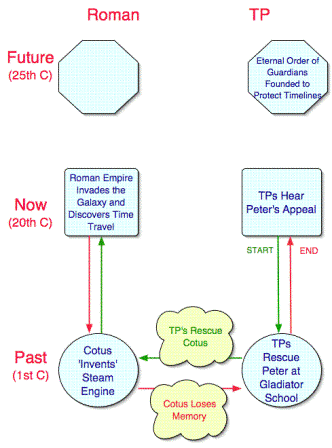 |
The Housefly Example and the Grandfather Paradox
To describe the possible effects of changing the past, John uses the example of a housefly settling on food. If a time traveller were to kill or otherwise disurb the fly, it would not continue in the path it would have taken. That path might have included settling on the food of a Roman soldier, who would have then caught food poisoning and died. If the soldier, now surviving the incident, then goes on to influence the outcome of a battle, the implications for the future development of history would be huge and the world in which the time traveller originated would no longer exist.
This is an example of the combined influence of two phenomena: The Butterfly Effect and the Grandfather Paradox.
The Butterfly Effect describes the observation that in complex systems, a small event - say the flapping of a butterfly's wings - could influence other, larger, events in turn, until the final consequences are huge - say the arrival of a hurricane on the other side of the planet. The Grandfather Paradox is a cautionary tale on the perils of time travel and the difficulties of comprehending it: If a time traveller were to kill his own grandfather, before his father was conceived, how could he be born himself to commit patricide?
 |
The Linear Timeline |
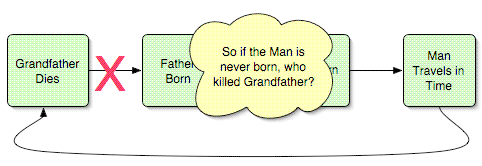 |
The Grandfather Paradox |
The Many Worlds Theory
In fact, there are mathematical arguements for suggesting that such a situation could not arise. These are fairly obscure however, and not at all intuitive. One widely hypothesised solution to the Grandfather Paradox is the Many Worlds Theory. This states that every action divides the universe into two timelines, in one of which that action occurs, and in the second it does not occur. So a man who shot his grandfather would originate in one timeline (where his grandfather lived) but create a second (in which he died). However, both timelines exist so there is no paradox in the action.
|
 |
A slight modification of this theory says that if the differences are small and the effects of the action wash out (i.e. that not every flap of a butterfly's wings cause that hurricane), the two timelines can merge again - this stops the number of universes becoming infinite.
Question One:
Why did Gaius and Co Dissappear when their timeline vanished, while Peter and the Tomorrow People did not?
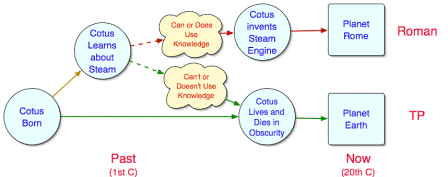
|
At the end of the serial, Gaius and his present-Roman soldiers disappear when their
timeline ceases to exist, even though they are in the first century when it happens. However, earlier in the story, the timeline to which Peter and the Tomorrow People belong apparently ceased to exist while they are in the first century, but they remain intact to travel forward into the Roman present.
Arguably, you could try to explain the dissappearence of Gaius and his people together with their universe, while the TPs and Peter survive the loss of their own, by a free will argument:
|
As the diagram above shows, the nexus point at which the two timelines - one leading to the TP's present and one to the interstellar Roman Empire - diverge is Cotus's invention, or failure to invent the steam engine. When Cotus gains the knowledge of how to use the steam engine, he has the option whether or not to use it - until he chooses or the option is removed, the two timelines can exist in parallel with the one he's mostly likely to choose being dominant. Thus the TPs
still have some probability of existence (if he chooses not to use the knowledge) and that, together with their time displacement, lets them survive into the dominant (Roman) timeline even though their own timeline is too weak for independent existence. When Cotus loses his memory there are no longer two choices for him to make so the timeline solidifies into the form in which he doesn't spread the knowledge of steam power, and Gaius and his men have no probability of existence.
This explanation would only work if the loss of memory Cotus endures is permanent and total.
Question Two:
Where and when did Gaius originate?
The motives and personal timeline of the Gaius character apper obscure. He is clearly out of place in the history of the TP's timeline and his activities cause sufficient disruption to the timelanes to attract Peter's attention. So why and how does he cause this disruption? He is clearly present both in the past at the point at which the timelines split, and in the 20th century present in the Roman timeline. However it is not clear whether he recognises the Tomorrow People in one or both of these, except that he clearly recognises them as a threat.
There are at least three possible explanations for this observed behaviour:
- Possibility 1: Gaius is an alien
- If Gaius is an alien, he could interfere with Earth's history with no regard for the consequences to himself. He could then travel backwards and forwards in time, exploring the effects.
In this model, Gaius would be present in the past of the TPs timeline first (where he causes the change), and then in the present of the Roman one (where he explores its effects). However, for his influence to cause disruption to the timelines, he would have a time other than the 1st century AD (i.e. a time-travelling alien) otherwise his actions would be part of the normal passage of history.
Problem: Why would Gaius dissappear when his altered timeline does so? If he is not native to either timeline, he should revert to the 1st century in whichever timeline is dominant.
Note: See also Jackie Clark's theory of time loops for A Rift in Time.
- Possibility 2: Gaius is a Time Traveler from the Roman Timeline
-
In this scenario (see diagram below), Gaius originates from a period in the Roman timeline at which time travel has been invented, and the Roman timeline preexists the TP's. Gaius invents (or is an early user of) time travel and returns to the past. Knowing that the Romans had steam power (and perhaps knowing it was invented in Britain in the first century AD) he has no hesitation in teaching it to Cotus. However, if Cotus, who is clearly bright and able to grasp complicated concepts, was the original inventor of steam power anyway, Gaius's interference in taking over the gladiator school now alters his emotional and intellectual journey. He could become less likely to survive his time at the gladiator school and so a second timeline (The TPs') comes into existence.
Gaius now returns to his own time, but - seeing the TPs there - realises he must return to protect his timeline. Inadvertantly injuring Cotus, he instead destroys it and the only surviving timeline is the TPs which has usurped the smooth flow of the universe.
Problem: This theory hinges on Cotus being the pivotal person in the history of Gaius's timeline, regardless of his interference (otherwise how would the second timeline originate and why would Gaius vanish at the end?). Hence it calls for a surprising coincidence.
Alternate: An alternate version of the Gaius-as-Roman Hypothesis would see his first encounter with the TPs, and the inspiration for his use of time travel, during their visit to the Roman 20thC. In this case, he observes them, invents time travel to return to Roman times, sees them again (recognising them) when they first travel to 1AD in search of Peter, and when he flees them he returns briefly to the Roman 20thC to gather support before coming back to hunt them down.
Problem: The paradoxes in this theory keep increasing. If Gaius didn't return to the past until after he had seen the TPs, but the TPs didn't return to the past until Gaius disturbed the time lanes then the timelines form a mobius loop with no clear cause and effect. Hence this hypothesis could not be accomodated with a simple many worlds model, but would call instead for some flexible time loops. Also, it would not explain the apparently different time travel technologies Gaius uses before and after his first encounter with the TPs (in their linear chronology).
|
|
For Gaius:
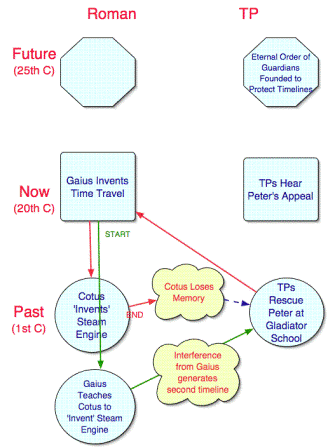
Note on Diagrams - time increases vertically. Arrows indicate the paths taken by individuals. Start on green arrow labeled 'START' and continue on green arrows until the only return option is red. Then continue on red arrows until they become blue (indicating a timeline shift) or 'END'. |
For Gaius:
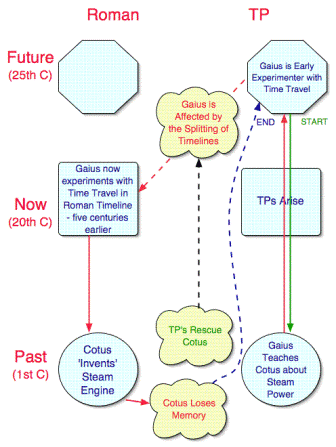 |
- Possibility 3: Gaius is a Time Traveler from the TP Timeline
-
If Gaius originates in the TP timeline, then he must come from a period close in time to that at which the Eternal Order of Guardians was founded. In those early days 'there was chaos' (Peter's words) and irresponsible travellers caused a great deal of damage to the timelanes.
In this scenario, (see below for diagram) Gaius travels back to the first century, teaches Cotus of steam power and travels forward to his own century with little regard for the consequences and before the TPs rescue Cotus. When Cotus is rescued and the timelines diverge, he is affected by the splitting (as the rest of the universe is) and is regenerated as a scientist in the 20th rather than 25th century (due to the more rapid technological development in the Roman timeline). He has no awareness of ever being anything other since he was in his natural timeline when it was replaced.
Now he follows the TPs back in time and inadvertantly corrects the damage he himself did, by injuring Cotus. Now the situation is the same as it was when he first left the first century - Cotus is alive but cannot use his knowledge of steam power. As far as he is concerned, the excursion into a Roman timeline did not occur so he reverts to his natural time in the TP future (fading from the past).
Problem: This theory now hinges on the coincidence that it is Gaius, rather than any other authority figure, who observed the TPs in the Roman present.
|
Comments are Welcome!
For my other TP related pages click here
The 1970s television series The Tomorrow People was created by Roger Price and is the property of Freemantle Media. The theories laid out above are meant as a logical extrapolation from events in the 1974 serial A Rift in Time and do not represent the views of its writer. These theories originated from a conversation which took place on the TPDIS mailing list - a forum for discussion of The Tomorrow People.
This page created by Elizabeth Stanway. Email me here.






